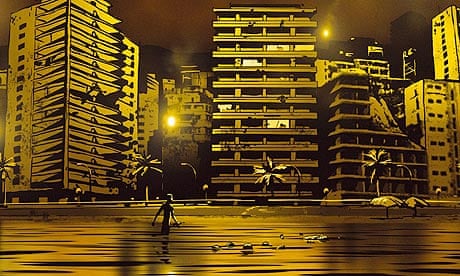Has Israel made a mass, semi-conscious decision to forget about the Sabra and Chatila massacres of the 1982 Lebanese war, in which Israeli forces allowed Christian Phalangist militia into Palestinian refugee camps to slaughter civilians? This extraordinary animated documentary by Israeli film-maker Ari Folman - a kind of fictionalised docu-autobiography - suggests that Israelis have indeed forgotten, in a kind of huge, willed amnesia. But his movie makes an acid-trip down memory lane, and Folman might have created his generation's very own Apocalypse Now.
Like that movie, it is open to the objection that the overdog's pain takes precedence over that of the oppressed, but this is a fascinating and often electrifying film in which Folman submits to his very own 'Nam flashback: a memory of how the Israel defence forces, of which he was a part, effectively presided over mass murder.
Over the past quarter-century, the massacre's horror has been absorbed and repressed within the Israeli mind, Folman suggests, but only partly. The very concept of Israel's partial or indirect guilt, established by the government's own Kahan commission, and therefore a guilt which Israel can concede without admitting to direct culpability, makes it a uniquely painful and potent subject. It's a reproach drifting just beneath the surface of memory and liable to break cover at any time.
Vivid and horrifying events leading up to the massacres are disinterred by the movie's quasi-fictional "reconstructive" procedure, somewhere between oral history and psychoanalysis. The film uses hyperreal rotoscope-animation techniques, similar to those made famous by Bob Sabiston and Richard Linklater. Live-action footage on videotape has been digitally converted into a bizarre dreamscape in which reality is resolved into something between two and three dimensions. Planes and surfaces stir and throb with colours harder, sharper, brighter than before. It looks like one long hallucination, and therefore perfect for the trauma of Folman's recovered memories.
The director, in grizzled middle age, is visited by a guy with whom he did military service. Over a beer, this man complains that he is plagued by a recurring dream about being chased by 26 savage dogs, and explains how the dream relates to the 1982 Lebanese war - a period to which he has hardly given a second thought before now, but which has mysteriously returned to plague him. Folman realises something that his friend can hardly believe: he simply cannot remember if he was anywhere near the camps, and can't remember anything distinctly about the war at all. He does not appear to be suffering from amnesia, particularly, and neither are there definite, sharp-edged holes in his memory. It is just a fuzz. So he goes on a journey to track down his old comrades; he asks them to remember, and hopes these memories will reignite his own.
His only real memory is no memory at all: it is a dream, a reverie, in which he and his fellow teenage soldiers emerge from the sea and wade on to the beach at Beirut: like a slo-mo parody of a military landing, or like the evolutionary progress of torpid, amphibious creatures. His interviewees tell him ferociously real anecdotes of blood and terror - the enemy's and their own - anecdotes which put his dream into perspective. One remembers being on a marine troop transport, where he fantasised about a giant naked woman taking him away while the others were killed. Another tells him of a young Palestinian boy attacking his unit with a rocket launcher in an orchard: a bizarrely beautiful, almost bucolic episode. Another is almost killed in an ambush, and escapes by swimming out to sea in the moonlit night, round a headland, and miraculously rejoins his unit. How much of this really happened?
Little by little, Folman sneaks up on the subject of Sabra and Chatila. Was he there? Right there? A hundred yards away? Three hundred yards away? Or nowhere near? His confusion testifies to the fog of war, or perhaps to the fact that this fog is created as a way of not facing up to war-guilt. Or perhaps it shows the individual's dissociation from news events, his disoriented, perspectiveless feeling that what he sees on TV had nothing to do with him: history was happening somewhere overhead or behind his back.
Finally, the film puts him right at the scene of the crime, and there is a bold shift from animation to TV news footage. I am not sure quite what to make of this shift, and have an uncomfortable feeling that it is an aesthetic error, and a tacit concession that the animation techniques used until that moment are lacking in seriousness: once the tragedy is directly broached, they must be abandoned. A minor loss of nerve, perhaps. Never mind. This is still an extraordinary film - a military sortie into the past in which both we and Folman are embedded like traumatised reporters.
